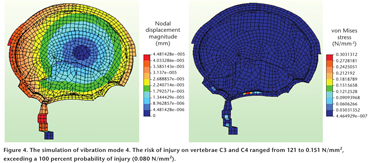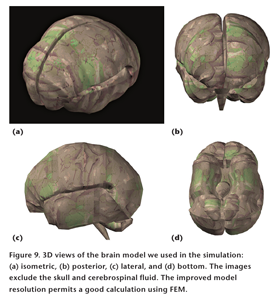Modeling Neck and Brain Injuries in Infants
By Ernesto Ponce & Daniel Ponce
NOTE: This is an introduction to the entire article, which appeared in the November/December issue of IEEE Computer Graphics and Applications magazine.
Click here to read the entire article.
Each year, there are many reported cases of brain and cervical lesions in infants, not only from falls or other accidents but also from child abuse as a result of violent shaking (called shaken baby syndrome, or SBS) or a blow to the head (called abusive head trauma, or AHT). The most prevalent types of brain lesions due to SBS are subskull bleeding and bleeding into the retina. Vigorous shaking can also cause neck injuries. Between 7 and 30 percent of SBS cases result in death; 30 to 50 percent result in serious cognitive and neurological disorders. Roughly 30 percent of cases have a chance of recovery, but with a high risk of long-term neurological problems.
The authors used the finite element method (FEM) to simulate how the vibrations due to shaking alters infants’ first through fourth cervical vertebrae (numbered C1 through C4, from the skull to the spine). They hypothesized that by combining FEM and vibration theory, they can predict and quantify such alterations. They also performed simulations of AHT. Here, they hypothesized that by using FEM and simulating the effects of dynamic impact, they can predict, locate, and quantify diffuse alterations in the brain.
The paper describes how the computer model was constructed using 2D computed tomography slices and 3D reconstructions. These were manipulated to create a 3D model using AutoCAD. The resulting model was imported into Algor (now Autodesk Simulation) FEM software.
The Algor software was used to simulate both vibrations and a head blow to the modeled skull/vertebrae. To analyze SBS, they subjected the model to a simulated 3-Hz vibration and 200-Newton horizontal sinusoidal force. For AHT, they treated the blow as a distributed load on the occipital area (a diffuse blow that leaves no outward signs). The total dynamic load was 400 N.
To determine the presence of cervical and brain injuries, they measured the von Mises stress. For each node, the von Mises stress combines into one value the stresses predicted in each axis.
The article is illustrated with results of the simulated displacement and von Mises stress for 6 different vibration modes and the head blow. Figure 4, taken from the article, shows one of the vibration simulations.
The article concludes:
“Our impact analysis model produced medically accurate findings. It works correctly when simulating impacts and shouldn’t require modification as long as we apply the same dynamic loads.
“FEM appears to be a practical, universal, economic, and fast tool with important forensic uses beyond detecting evidence of child abuse. For head and brain injuries, determining the damage mechanism is often difficult and normally requires sophisticated, expensive neuroimaging techniques. A good comprehension of FEM should help experts understand different head impact scenarios and impacts with different objects – including ballistic injuries – and correlate models with observed behavior in injuries. Such an objective method could be used to sustain evidence, support hypotheses, and verify post mortems.
“In addition, we’ve used our mathematical model to create high-quality images of the brain (see Figure 9). Such quality is important for improving the resolution of images of specific parts of the brain and improving the study of head injuries.”
AUTHORS
Ernesto Ponce is a professor of mechanical engineering at the Universidad de Tarapacá. Contact him at eponce@uta.cl.
Daniel Ponce is a PhD candidate in mechatronics in the mechanical department of the Universidad Federal de Santa Catarina. Contact him at danielpo25@gmail.com.








